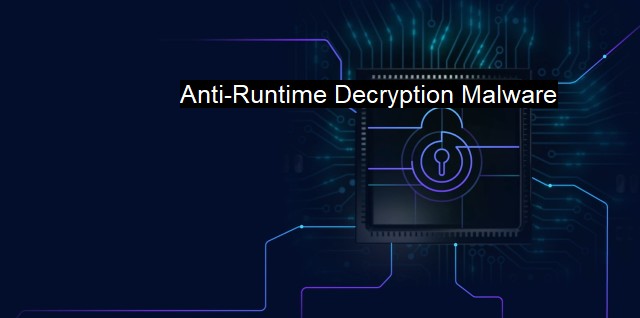What is Anti-Runtime Decryption Malware?
Exploring Anti-Runtime Decryption Malware: A Threat to Antivirus Detection Algorithms
Anti-runtime decryption malware, within the realm of cybersecurity and antivirus systems, refers to a specific genre of dangerous software designed to thwart defense mechanisms established to safeguard information and other sensitive data within a computing environment. This decryption malware operates like a quicksilver, adapting and evolving quickly that antivirus systems find it hard to keep pace.To understand how 'anti-runtime decryption' malware operates, it must be noted that ground zero for the functionalities of these malwares hinges on leveraging sophisticated techniques for bypassing antivirus software.
There exists a symbiotic relationship between encryption and decryption. Encryption involves converting useful information into code to prevent unauthorized access, whereas decryption is the subsequent steps to convert this coded data back to its original form, in a process synonymous to deciphering encrypted information. Malware often applies sophisticated decryption techniques to break through the radars of antivirus sensors.
Traditionally, malware penetrates an unsuspecting victim's device through emails or corrupted downloads. with their modern upgrades, they have the tactical ability to imitate or impersonate a legitimate file, turning it into a harmful virus without arousing suspicion from the antivirus installed on the device.
Anti-runtime decryption malware, in particular, is designed to prevent the runtime decryption necessary for enforcing cybersecurity. It infects your computer system, burrowing deep and latching onto your system's processes, ultimately preying on delicate information like banking details, personal photographs, and other sensitive data.
One alarming attribute of this kind of malware is its ability to propagate quickly. Once anti-runtime decryption malware makes its way into a system, the catastrophic effects ripple throughout the computing environment, thereby impacting overall operational efficiency and data integrity.
The principle strategy employed by the anti-runtime decryption malware consists of disrupting 'runtime decryption' processes embedded in the system's software architecture. This permits them to disseminate rapidly, exploit system vulnerabilities, and establish an information highway for an unauthorized data exfiltration. The compromised system may even suffer considerable damage, requiring expensive system overhauls and replacements.
Server farms, data centers, and organizations operating cloud storage systems are at an elevated risk of becoming prey to anti-runtime decryption malware. Since cloud-based services cache data in runtime decryption configurations for instantaneous access, they are the primary target for this genre of malware.
These malwares emulate digital signatures almost impeccably deceiving the antivirus software into marking them as trusted files allowing them to operate with free rein. If unchecked, these malwares can cause heavy financial and operational losses causing irreversible damage.
With that said, countermeasures and detection technologies to identify and corporately deal with such malwares have significantly evolved. Some key security practices providing relief from malware attacks include routine system audits, assiduous system patching, network intrusion detection systems, cryptographic techniques, proactive threat hunting, firewall configurations, and gateway filtering.
The advent and rapid mutations of anti-runtime decryption malware highlight an intense cat-and-mouse game ongoing in the strata of cybersecurity. Users need to stay adaptive to thwart such cyber threats, emphasizing an accurate understanding of anti-runtime decryption malware. As long as technology continues to advance and evolve multiplicatively, counteracting these cyber threats will continue to be an imminent mission for cybersecurity experts worldwide.

Anti-Runtime Decryption Malware FAQs
What is anti-runtime decryption malware?
Anti-runtime decryption malware is a type of malicious software that targets the runtime environment of a computer system to evade detection by antivirus products. It is designed to bypass the security measures put in place by antivirus products, making it difficult to detect and remove from a system.How does anti-runtime decryption malware work?
Anti-runtime decryption malware works by encrypting the malicious code to make it difficult for antivirus products to detect it. It uses various techniques such as self-modifying code and code obfuscation to evade signature-based detection. The malware then decrypts itself at runtime, making it difficult to detect and analyze.What are the consequences of being infected with anti-runtime decryption malware?
Being infected with anti-runtime decryption malware can have severe consequences for a system. It can allow cybercriminals to gain access to your sensitive information, such as login credentials, financial information, and personal data. The malware may also install additional malicious software on your computer, allowing the attacker to control your system remotely.How can I protect my computer from anti-runtime decryption malware?
There are several measures you can take to protect your computer from anti-runtime decryption malware. Keeping your antivirus software up to date and running regular scans is one of the most important things you can do. It is also essential to keep your operating system and software updated with the latest security patches. Additionally, you should practice safe browsing habits, such as avoiding suspicious websites and not opening email attachments from unknown senders.| | A | | | B | | | C | | | D | | | E | | | F | | | G | | | H | | | I | | | J | | | K | | | L | | | M | |
| | N | | | O | | | P | | | Q | | | R | | | S | | | T | | | U | | | V | | | W | | | X | | | Y | | | Z | |
| | 1 | | | 2 | | | 3 | | | 4 | | | 7 | | | 8 | | |||||||